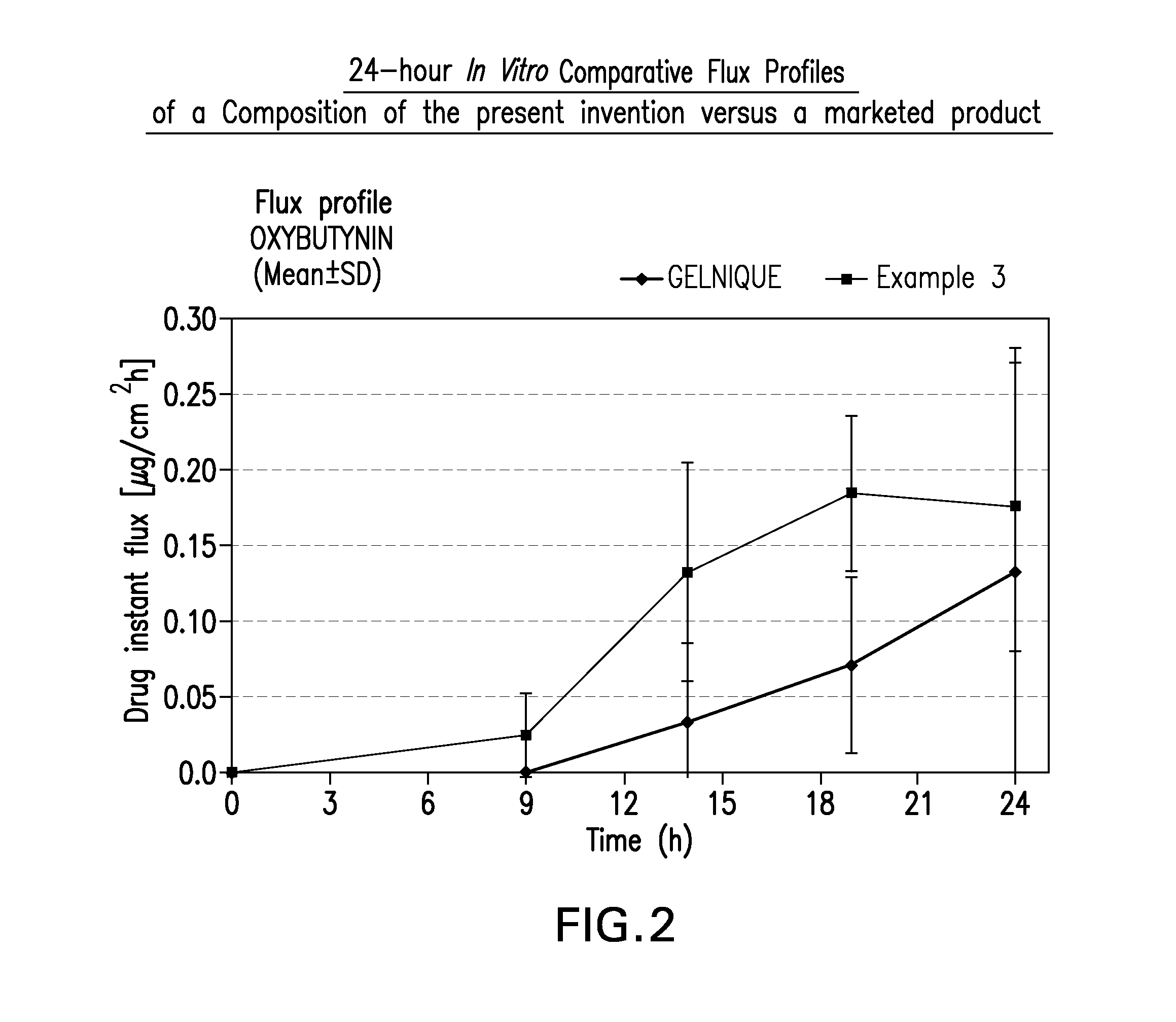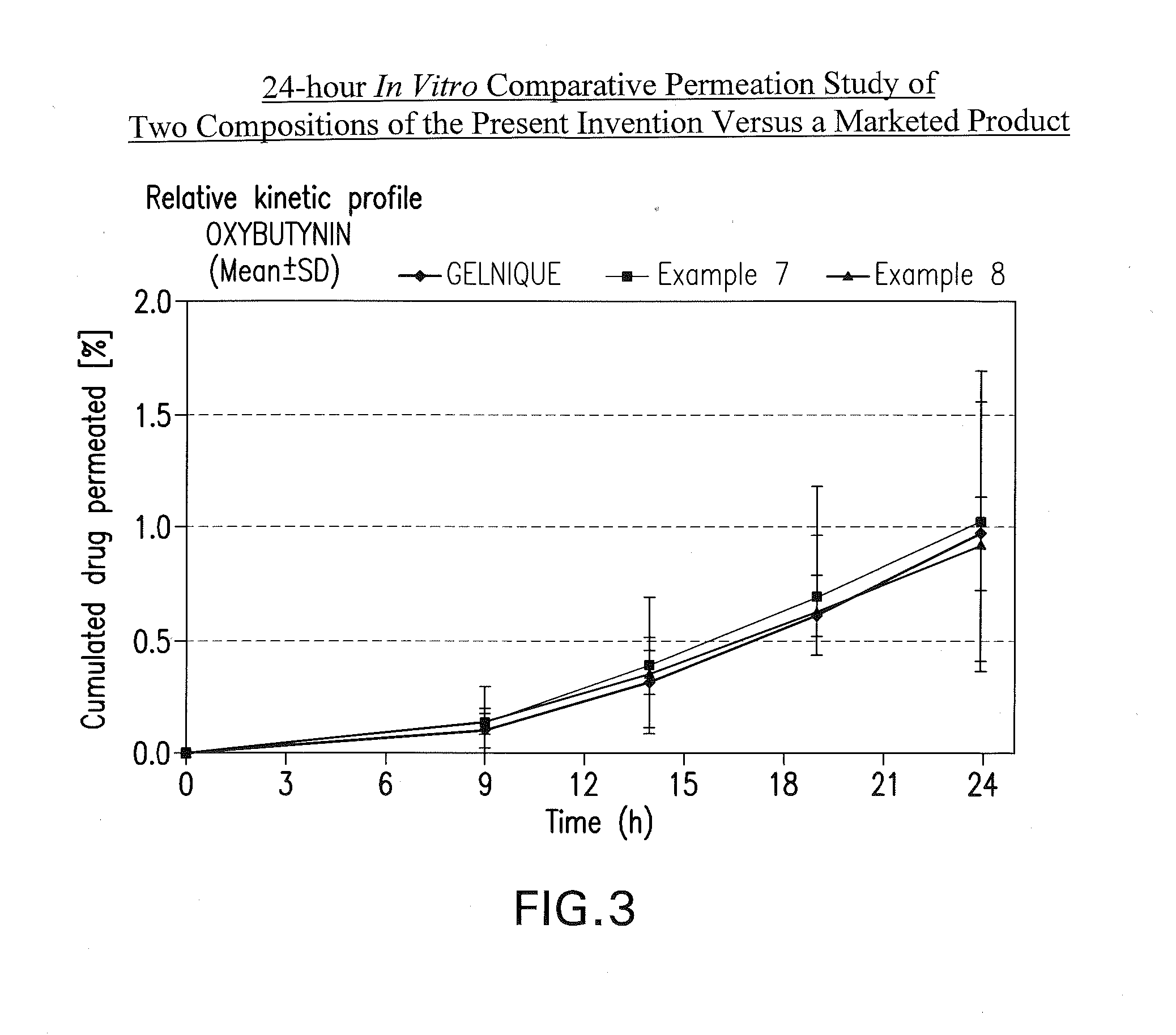Transdermal compositions for anticholinergic agents
a technology of cholinergic agents and compositions, applied in the direction of biocide, plant growth regulators, pharmaceutical non-active ingredients, etc., can solve the problems of drug concentration peaks, drug concentration drops, undesirable side effects, etc., to avoid undesirable drug concentration peaks and reduce the incidence of unwanted effects
- Summary
- Abstract
- Description
- Claims
- Application Information
AI Technical Summary
Benefits of technology
Problems solved by technology
Method used
Image
Examples
example 1
[0064]A gel composed by oxybutynin free base 1 w / w to 5% w / w, anhydrous ethanol 45% w / w to 75% w / w, diethylene glycol monoethyl ether 1% w / w to 15% w / w, propylene glycol 1% w / w to 30% w / w, hydroxypropylcellulose (KLUCEL™ HF Pharm) 0.5% w / w to 2% w / w, hydrochloric acid HCl q. ad. for pH 4 to 9, and purified water q. ad. for 100% w / w, was prepared by dissolving the oxybutynin free base in the ethanol / propylene glycol / diethylene glycol monoethyl ether mixture. Purified water was then added and pH adjusted to the target with hydrochloric acid solution. Hydroxypropylcellulose was then thoroughly dispersed in the hydro-alcoholic solution under mechanical stirring at room temperature at a suitable speed ensuring good homogenization of the formulation while avoiding lumps formation and air entrapment until complete swelling.
example 2
[0065]A gel composed by oxybutynin free base 3% w / w, anhydrous ethanol 50% w / w, diethylene glycol monoethyl ether 5% w / w, propylene glycol 15% w / w, hydroxypropylcellulose (KLUCEL™ HF Pharm) 1.5% w / w, hydrochloric acid HCl q. ad. for pH 7 to 8, and purified water q. ad. for 100% w / w, was prepared according to manufacturing process described in Example 1.
example 3
[0066]A gel composed by oxybutynin free base 3% w / w, ethanol 96% w / w˜55% w / w, diethylene glycol monoethyl ether 2.5% w / w, propylene glycol 20% w / w, hydroxypropylcellulose (KLUCEL™ HF Pharm) 1.5% w / w, butylhydroxytoluene (BHT) 0.05% w / w, hydrochloric acid HCl q. ad. for pH 7 to 8, and purified water q. ad. for 100% w / w, was prepared according to manufacturing process described in Example 1, wherein BHT is added to the ethanol / propylene glycol / diethylene glycol monoethyl ether mixture.
PUM
| Property | Measurement | Unit |
|---|---|---|
| distance | aaaaa | aaaaa |
| pH | aaaaa | aaaaa |
| pH | aaaaa | aaaaa |
Abstract
Description
Claims
Application Information
 Login to View More
Login to View More - R&D
- Intellectual Property
- Life Sciences
- Materials
- Tech Scout
- Unparalleled Data Quality
- Higher Quality Content
- 60% Fewer Hallucinations
Browse by: Latest US Patents, China's latest patents, Technical Efficacy Thesaurus, Application Domain, Technology Topic, Popular Technical Reports.
© 2025 PatSnap. All rights reserved.Legal|Privacy policy|Modern Slavery Act Transparency Statement|Sitemap|About US| Contact US: help@patsnap.com



